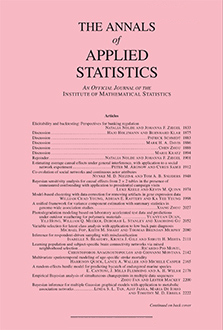Abstract
Although many studies collect biomedical time series signals from multiple subjects, there is a dearth of models and methods for assessing the association between frequency domain properties of time series and other study outcomes. This article introduces the random Cramér representation as a joint model for collections of time series and static outcomes where power spectra are random functions that are correlated with the outcomes. A canonical correlation analysis between cepstral coefficients and static outcomes is developed to provide a flexible yet interpretable measure of association. Estimates of the canonical correlations and weight functions are obtained from a canonical correlation analysis between the static outcomes and maximum Whittle likelihood estimates of truncated cepstral coefficients. The proposed methodology is used to analyze the association between the spectrum of heart rate variability and measures of sleep duration and fragmentation in a study of older adults who serve as the primary caregiver for their ill spouse.
Citation
Robert T. Krafty. Martica Hall. "Canonical correlation analysis between time series and static outcomes, with application to the spectral analysis of heart rate variability." Ann. Appl. Stat. 7 (1) 570 - 587, March 2013. https://doi.org/10.1214/12-AOAS601
Information





